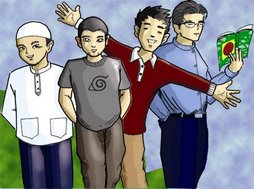

Chirag Trivedi BBC News Online, London
Since Roman times, London has been known to people abroad as a land of mists and fogs. Until recently visitors to the city could take home with them tins of 'London fog'.
But the London smog of 1952 had more serious consequences.
On Friday 5 December 1952 a dense smoke-filled fog shrouded London and brought the city to a standstill for four days.
Motor vehicles were abandoned, trains were disrupted and airports were forced to close.
Cattle casualties
A Ministry of Health report estimated that 4,075 more people had died than would have been expected to under normal conditions.
"In a city traditionally notorious for its fogs there was general agreement on its exceptional severity on this occasion," the Ministry said.
The first reported casualties of the smog were cattle at the Smithfield Show.
At Sadler's Wells, the opera La Traviata had to be abandoned after the first act because the theatre was so full of smog.
Public transport ground to a halt
But it was the coroners and doctors in the city's hospital who first became aware of its deadly effects.
Most victims died from respiratory or cardiovascular problems but only those "prone to such ailments" were affected.
The main pollutants were believed to be by-products of coal burning which was said to have reached "exceptional levels".
And high pressure, near freezing temperatures and very light winds kept the smog hanging over London.
No school
But to the great majority of healthy individuals, the smog was little more than a nuisance.
One of those that experienced it was Ken Livingstone, the current Mayor of London, who "didn't have to go to school for a few days".
"The fog was simply so thick that parents were advised not to risk letting their children get lost on the way to school, unless it was literally round the corner."
He added: "When my parents went out they had to cover their nose and mouth with a handkerchief.
The Great Smog
5-9 Dec, 1952
Laced with sulphur dioxide, nitrogen oxides and soot
Caused by pollution and extreme cold"In response to the 1952 smog, the Government passed legislation to phase out coal fires, which meant initially many people transferred to paraffin heaters.
"I have to say that I was quite pleased because it was my job to go out and clean the fire out in the morning - raking out all the bits of unburned coal to save them for the next fire."
The battle for better air quality continues. Mr Livingstone has to meet tough targets imposed by the government and the European Union.
London has 80 monitoring stations dotted all over the city.
Air Quality minister Alun Michael visits a pollution monitoring unitInside each are computers and monitoring equipment that suck in air and measure the levels of carbon monoxide, nitrogen dioxide and other pollutants.
They also analyse fine particulates - very small pieces of pollution that can get deep down into the lungs.
On Thursday, after visiting one of these stations on Marylebone Road in central London, air quality minister Alun Michael said: "I remember the smogs Londoners suffered as I visited the capital most autumns as a child. They were awful.
"Nowadays, partly as a result of the Clean Air Act, we are lucky to enjoy much better air quality."
Targets missed
But it is estimated that London will not achieve the annual government targets for nitrogen dioxide (NO2) and daily fine particles.
Levels for both pollutants are expected to exceed their targets along the major road networks.
In addition, NO2 levels are also expected to exceed targets for central London and around Heathrow Airport.
Despite this, Gary Fuller from the environmental research group at King's College London, said: "Air quality has improved vastly in London, simply because we don't burn much coal anymore.
"The main threat is obviously cars. It's a case of can we improve air quality fast enough as more and more cars come onto the roads."
WATCH/LISTEN
ON THIS STORY
The BBC's Tom Heap"Our air is a lot clearer than it was 50 years ago but it is not clean"
See also:
05 Dec 02 Health
Historic smog death toll rises
05 Dec 02 England
In pictures: The Great Smog of London
05 Dec 02 UK
Days of toxic darkness
05 Dec 02 England
Pollution call on smog anniversary
12 Aug 02 Science/Nature
Deadly Asian haze 'can be tamed'
10 Jul 01 Asia-Pacific
Smog fears grow across SE Asia
Internet links:
Mayor of London
Kings College London: Air Quality Index
Department for Environment Food and Rural Affairs
Met Office: 1952 Smog
National Society for Clean Air and Environmental Protection
Big Smoke Conference The BBC is not responsible for the content of external internet sites
Top England stories now:
10,000 chased for congestion fine
Teenagers admit festival violence
Postmaster sacked over robbery
Beckham forgives Ferguson
Man faces nine rape charges
Abuse claimants win compensation
400 jobs to go at zinc works
Legal row cat back with owners
http://news.bbc.co.uk/1/hi/england/2545759.stm
by ann nabilla






Tiada ulasan:
Catat Ulasan